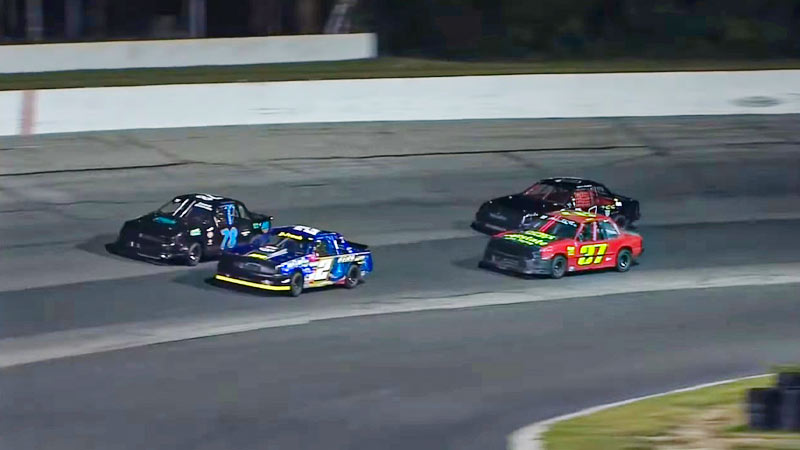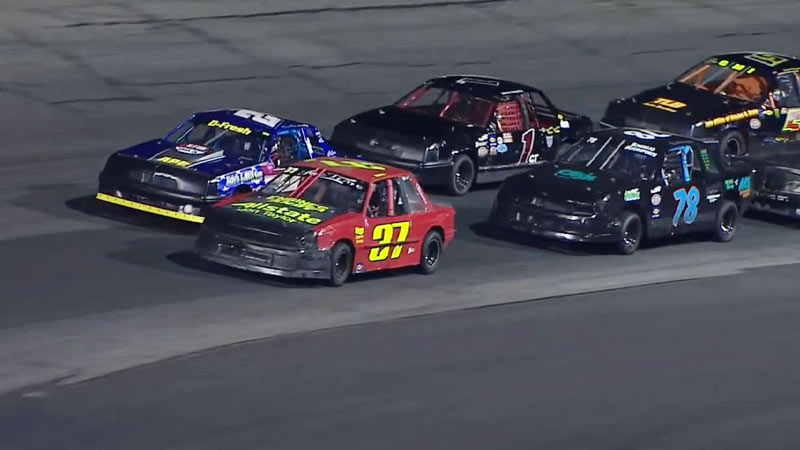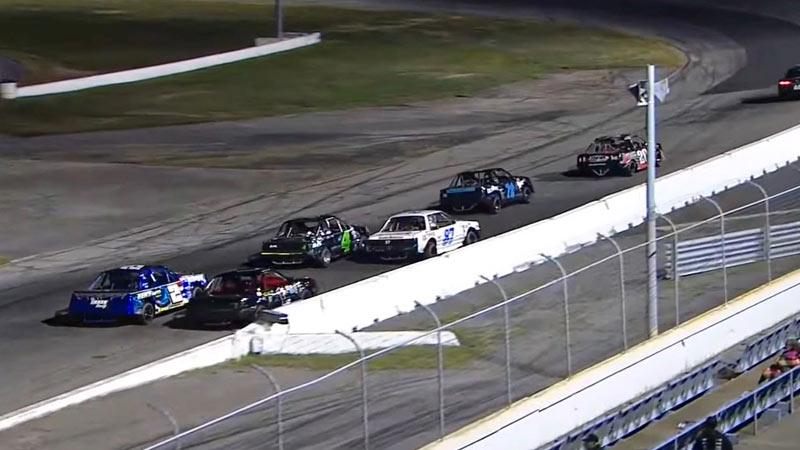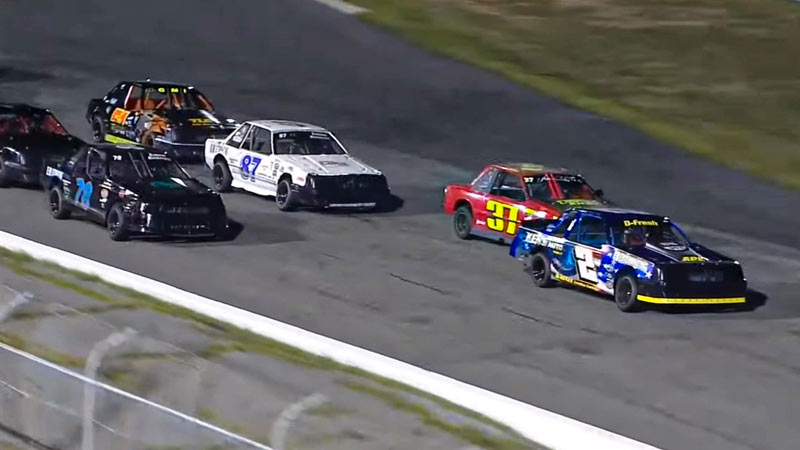Let’s join on the pulsating journey of Mini Stock Car Racing unveils a dynamic world where racing enthusiasts converge to experience the essence of grassroots motorsports.
This accessible and adrenaline-charged category traces its roots to the mid-20th century, offering a platform where passion meets ingenuity.
From affordable vehicle modifications to the strategic dance on oval tracks, each facet of mini-stock car racing contributes to a tapestry woven with skill, camaraderie, and the pursuit of speed.
As we delve into the basics of this racing phenomenon, we’ll unravel the history, safety measures, and myriad benefits that make mini-stock car racing a captivating realm for both participants and spectators.
What Is Mini Stock Car Racing?
It’s a very common question people ask about what is a mini stock race car. Mini-stock car racing typically involves smaller, less powerful cars that are modified for racing on oval tracks.
These cars are often compact and affordable, making them a popular choice for grassroots racing. The modifications can include changes to the engine, suspension, and other components to enhance performance and safety.
It’s a more accessible entry point into the world of stock car racing for many enthusiasts who may not have the resources for higher-level competition.
The emphasis is often on skill and strategy rather than sheer speed, making it a thrilling experience for both drivers and spectators.
The Basics of Mini Stocks Car Racing
In the dynamic realm of motorsports, mini-stock car racing stands as a vibrant and accessible avenue for enthusiasts.
Here, the thrill of competition converges with the ingenuity of modifications, creating a captivating spectacle on oval tracks.
Delving into the basics of this racing category unveils a tapestry woven with passion and skill, where pint-sized cars transform into formidable contenders.
Vehicle Selection
Mini-stock cars are typically compact, economical models that undergo strategic modifications for racing.
Popular choices include hatchbacks and sedans, known for their agility on the track.
Engine Modifications
The heart of mini-stock cars undergoes transformations to amplify performance.
Engine modifications may include enhancements to horsepower, torque, and overall efficiency, striking a balance between power and reliability.
Suspension Enhancements
Achieving optimal handling is paramount in mini-stock car racing.
Suspension systems are fine-tuned to navigate the twists and turns of oval tracks with precision, offering drivers the responsiveness needed for a competitive edge.
Safety Measures
Despite their smaller stature, safety is paramount in mini-stock car racing.
Vehicles are equipped with roll cages, racing seats, and harnesses to protect drivers in the event of collisions or mishaps, ensuring a secure environment on the track.
Tire Selection
Tires play a crucial role in the performance of mini-stock cars.
The choice of tires, along with precise tire pressure adjustments, allows drivers to maximize traction and control, especially during tight corners and high-speed stretches.
Strategic Racing Tactics
Mini-stock car racing is not merely a test of speed but a strategic dance on the oval stage.
Drivers often employ tactics such as drafting, overtaking, and maintaining optimal racing lines to outmaneuver opponents and secure a competitive advantage.
Affordability and Accessibility
One of the defining features of mini-stock car racing is its affordability and accessibility.
Enthusiasts with a passion for racing can enter the arena without breaking the bank, fostering a community where skill and determination take precedence over extravagant budgets.
In essence, mini-stock car racing encapsulates the essence of grassroots motorsports—a vibrant fusion of mechanical prowess, strategic acumen, and the unbridled joy of competition.
History of Mini Stock Car Racing
The roots of mini stock car racing can be traced back to the mid-20th century, as an organic response to the burgeoning interest in stock car competitions across the United States.
Emerging as a more accessible alternative to traditional stock car racing, mini-stock car racing found its niche among grassroots motorsports enthusiasts, creating a platform where skill and ingenuity superseded financial prowess.
Origins in Stock Car Racing
The origins of mini-stock car racing lie in the broader realm of stock car racing, which gained immense popularity in post-World War II America.
As interest in the sport grew, so did the desire for a more affordable and entry-level racing category.
Rise of Grassroots Motorsports
In the 1960s and 1970s, grassroots motorsports began to flourish as individuals sought avenues to participate in racing without the financial burden associated with higher-tier competitions.
Mini-stock car racing emerged as a response to this demand, providing a more accessible entry point for aspiring racers.
Affordable Vehicle Options
One of the defining features of mini-stock car racing is the use of readily available, affordable vehicles. Racers often convert compact cars, known for their affordability and ease of modification, into competitive mini-stock cars.
This democratization of the sport allowed a broader range of enthusiasts to engage in racing.
DIY Culture and Modifications
Mini-stock car racing embraced a do-it-yourself (DIY) culture, where racers became adept at modifying their vehicles for enhanced performance.
Engine tweaks, suspension modifications, and other adjustments became common practices, creating a culture of innovation and experimentation.
Oval Track Dominance
Mini-stock car racing predominantly takes place on oval tracks, distinguishing it from other forms of racing.
The tight turns and short straights of these tracks demand a unique set of skills, emphasizing precision, agility, and strategic maneuvering.
Local and Regional Circuits
As the popularity of mini-stock car racing grew, local and regional circuits dedicated to this category began to emerge.
These circuits became breeding grounds for aspiring racers, allowing them to hone their skills in a competitive yet supportive environment.
Evolution and Recognition
Over the decades, mini-stock car racing evolved both in terms of technology and recognition.
The category gained credibility as a legitimate form of motorsports, attracting sponsors and garnering attention from fans who appreciated the close-quarters, thrilling nature of the races.
Influence on Driver Development
Many seasoned professional drivers trace their roots back to mini-stock car racing.
The skills honed on the smaller tracks often served as a launching pad for careers in higher-tier racing series, showcasing the developmental significance of this category.
In essence, the history of mini-stock car racing is woven into the fabric of grassroots motorsports—a testament to the enduring appeal of affordable, skill-based competitions that capture the essence of racing in its purest form.
Safety Measure in Mini Stock Race Car
Safety is a paramount concern in mini-stock car racing, despite the smaller size and seemingly lower speeds compared to higher-tier Mini Stock Racing categories.
Several measures are implemented to ensure the well-being of drivers, pit crews, and spectators:
Roll Cages
Mini-stock cars are equipped with sturdy roll cages that surround the driver’s compartment. These cages are constructed from high-strength materials to provide a protective barrier in the event of a rollover or collision.
Racing Seats and Harnesses
Specialized Mini Stock Racing seats designed to absorb impact and minimize injury are installed in mini stock cars.
Additionally, drivers are secured in their seats with multi-point harnesses, ensuring they remain securely in place during high-speed maneuvers or accidents.
Fire Suppression Systems
Given the potential for engine or fuel-related incidents, mini-stock cars are often equipped with fire suppression systems.
These systems deploy fire-retardant substances to quickly extinguish flames and minimize the risk of serious injuries.
Window Nets and Bars
Window nets serve as an additional safety feature, preventing a driver’s limbs from protruding outside the vehicle in the event of a crash.
Some mini-stock cars also incorporate side impact bars to enhance protection in side collisions.
Fuel Cell Technology
Traditional fuel tanks are replaced with fuel cells in mini-stock cars. Fuel cells are designed to be more resistant to rupture upon impact, reducing the risk of fires and enhancing overall safety on the track.
Driver Gear
Drivers wear specialized safety gear, including flame-resistant suits, gloves, and helmets.
These components provide an additional layer of protection against fire and impact, ensuring that drivers are well-prepared for the demands of high-speed racing.
The safety measures in mini-stock car racing are a comprehensive blend of vehicle design, driver equipment, track considerations, and emergency preparedness.
These measures collectively create an environment where the thrill of racing coexists with a commitment to minimizing the inherent risks associated with high-speed competition.
Benefits and Opportunities in Ministock Race Car
Participating in mini stock car racing offers enthusiasts a myriad of benefits and opportunities, contributing to the growth of grassroots motorsports and individual development:
Affordability
Mini-stock car racing is often more budget-friendly compared to higher-tier racing categories.
The use of readily available, economical vehicles and the emphasis on grassroots modifications make it accessible to a broader range of enthusiasts who may not have the financial resources for more expensive forms of racing.
Skill Development
Racing in the mini-stock category provides an ideal platform for developing essential racing skills.
Drivers learn the nuances of handling, strategy, and precision driving, honing their abilities in a competitive yet supportive environment.
Gateway to Professional Racing
Many professional racing careers have roots in mini-stock car racing.
The skills acquired on smaller tracks can serve as a launching pad for those aspiring to progress to higher-tier racing series, offering a pathway for individuals with talent and determination.
Community and Camaraderie
Mini-stock car racing fosters a sense of community and camaraderie among participants.
Local and regional circuits often become tight-knit communities where racers share experiences, knowledge, and a passion for the sport, creating lasting connections.
Sponsorship Opportunities
Successful participation in mini-stock car racing can attract sponsors, even at the grassroots level.
Sponsors may provide financial support, equipment, or other resources, helping drivers offset some of the costs associated with racing and facilitating further advancement in the sport.
Mechanical and Engineering Understanding
Enthusiasts involved in mini-stock car racing gain a hands-on understanding of vehicle mechanics and engineering.
The process of modifying and maintaining their race cars enhances participants’ technical knowledge, providing a valuable learning experience.
The benefits and opportunities in mini-stock car racing extend far beyond the thrill of the race itself.
From skill development and community building to potential pathways to professional racing, participating in this category opens doors to a world where passion and practical experience converge.
FAQs
Are mini-stock cars good?
Mini-stock cars are popular for their affordability, accessibility, and thrilling racing experience.
These smaller, modified vehicles provide an excellent entry point into motorsports, allowing drivers to hone their skills without the financial burden often associated with higher-tier racing categories.
What is the latest mini-late model?
Specific models may vary, but late models in mini-stock car racing typically include compact cars modified for racing performance.
Popular choices include the Honda Civic, Ford Focus, and Chevrolet Cavalier, among others. It’s advisable to check with racing associations or manufacturers for the most current information on the latest mini-late models.
How do mini-stock cars differ from other racing categories?
Mini-stock cars distinguish themselves through their compact size, modified components, and affordability.
Unlike larger racing categories, mini-stock cars often use stock production models as a base, making modifications more accessible to enthusiasts. This creates a competitive and exciting racing environment.
What are the key modifications in mini-stock car racing?
Mini-stock car modifications include enhancements to engine performance, suspension systems, and safety features. These modifications aim to optimize the vehicle for racing while maintaining cost-effectiveness.
Upgrades such as roll cages, racing tires, and aerodynamic adjustments contribute to the overall performance of the mini-stock car.
How can one get involved in mini-stock car racing?
Getting involved in mini-stock car racing typically starts with a passion for motorsports. Enthusiasts can explore local racing circuits, join racing clubs, or connect with experienced drivers and teams.
Acquiring a suitable mini-stock car, understanding racing regulations, and participating in events or competitions are crucial steps toward entering the exhilarating world of mini-stock car racing.
Wrapping Up
In the realm of Mini Stock Car Racing, we’ve traversed the winding tracks where passion meets precision, and affordability intertwines with adrenaline.
From its humble origins rooted in the annals of stock car racing to the vibrant community it has fostered today, this category stands as a testament to the enduring spirit of grassroots motorsports.
The safety measures meticulously woven into the fabric of mini-stock car racing exemplify a commitment to both thrill and well-being.
As drivers navigate the tight turns and exhilarating straights, they not only race toward victory but also toward personal growth and skill development.
Whether a stepping stone to professional racing or a lifelong pursuit of joy on the oval, mini-stock car racing encapsulates the sheer essence of speed, skill, and the indomitable spirit of those who dare to chase the checkered flag.




